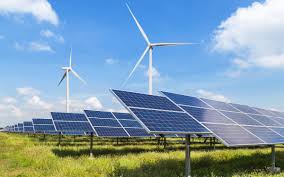The Wonders of Electricity
Electricity is a fundamental part of modern life, powering our homes, businesses, and technology. It is a form of energy resulting from the existence of charged particles (such as electrons or protons), either statically as an accumulation of charge or dynamically as a current.
The discovery and harnessing of electricity have revolutionized the world in countless ways. From lighting up our homes to driving technological advancements, electricity plays a crucial role in almost every aspect of our daily lives.
Electricity is generated through various means, including fossil fuels, nuclear power, hydroelectric dams, wind turbines, and solar panels. The distribution and transmission of electricity involve complex networks of power lines and substations to ensure that it reaches us safely and reliably.
One of the most remarkable features of electricity is its versatility. It can be converted into different forms of energy such as light (as in bulbs), heat (as in electric stoves), motion (as in motors), and sound (as in speakers). This flexibility makes electricity a cornerstone of innovation and progress.
However, with great power comes great responsibility. While electricity has brought immense benefits to society, it also poses risks if not handled properly. Electrical safety measures are essential to prevent accidents and ensure the smooth functioning of electrical systems.
In conclusion, electricity is a marvel that powers our world and drives human advancement. Understanding its principles and applications is key to making the most out of this incredible force of nature.
Understanding Electricity: Answers to Common Questions
- What is electricity?
- How is electricity generated?
- What are the different sources of electricity?
- How does electricity reach our homes and businesses?
- What are the dangers associated with electricity?
- How can I save energy at home?
- Are there renewable sources of electricity?
- What is an electric circuit?
- How does static electricity work?
What is electricity?
Electricity is a fundamental form of energy that powers our modern world. It is a versatile and essential force that results from the movement of charged particles, such as electrons. In simple terms, electricity is the flow of electrical power through conductors, enabling us to light up our homes, operate electronic devices, and drive technological innovations. Understanding the nature of electricity is crucial for appreciating its significance in our daily lives and for ensuring its safe and efficient use across various applications.
How is electricity generated?
Electricity is generated through various methods that harness different energy sources. One common way is through power plants that burn fossil fuels like coal, oil, or natural gas to produce heat, which then generates steam to turn turbines connected to generators. Nuclear power plants use nuclear reactions to create heat for the same purpose. Renewable energy sources such as wind, solar, and hydroelectric power also play a significant role in electricity generation by harnessing natural elements like sunlight, wind, and flowing water to produce clean energy. These diverse methods highlight the ingenuity and innovation behind the generation of electricity to meet our growing energy needs sustainably.
What are the different sources of electricity?
There are various sources of electricity that power our modern world. These include traditional sources such as fossil fuels like coal, natural gas, and oil, which are burned to generate electricity. Renewable sources such as wind, solar, hydroelectric, and geothermal energy have gained popularity due to their sustainability and environmental benefits. Nuclear power plants harness the energy released from nuclear reactions to produce electricity. Each source has its advantages and challenges, influencing the energy mix and shaping the future of electricity generation.
How does electricity reach our homes and businesses?
Electricity reaches our homes and businesses through a complex system of generation, transmission, and distribution. Initially, electricity is generated at power plants using various sources such as fossil fuels, nuclear energy, renewable sources like wind or solar, or hydroelectric dams. Once generated, the electricity is transmitted over long distances through high-voltage power lines to substations. At these substations, the voltage is reduced for safer distribution along local power lines that run through neighbourhoods and commercial areas. Finally, the electricity enters our homes and businesses through meters connected to the main electrical grid, allowing us to access this essential source of power for our daily needs. This intricate process ensures that electricity is delivered efficiently and reliably to meet the demands of modern society.
What are the dangers associated with electricity?
Electricity, while a vital part of modern life, poses significant dangers if not handled with care and caution. One of the primary risks is electric shock, which can occur when the body becomes part of an electrical circuit. This can lead to injuries ranging from minor burns to fatal consequences. Additionally, electrical fires are a common hazard, often caused by faulty wiring or overloaded circuits. Another danger is the potential for electrical appliances or equipment to malfunction and cause damage or injury. It is crucial to be aware of these risks and take necessary precautions to ensure electrical safety in our homes and workplaces.
How can I save energy at home?
One frequently asked question regarding electricity is, “How can I save energy at home?” There are several simple yet effective ways to reduce energy consumption and lower your electricity bills. One method is to switch to energy-efficient appliances and lighting, such as LED bulbs and ENERGY STAR-rated devices. Additionally, adjusting your thermostat to an optimal temperature, properly insulating your home, and unplugging electronics when not in use can all contribute to saving energy. By being mindful of your energy usage and implementing these practices, you can make a positive impact on both the environment and your household expenses.
Are there renewable sources of electricity?
Yes, there are renewable sources of electricity that offer sustainable and environmentally friendly alternatives to traditional fossil fuel-based power generation. Renewable sources such as solar, wind, hydroelectric, and geothermal energy harness the natural elements to generate electricity without depleting finite resources or emitting harmful greenhouse gases. These clean energy sources have gained popularity due to their potential to reduce carbon emissions and combat climate change. Embracing renewable sources of electricity is crucial in transitioning towards a more sustainable energy future for the benefit of both current and future generations.
What is an electric circuit?
An electric circuit is a closed loop through which electric current can flow. It consists of various components such as wires, resistors, capacitors, and power sources like batteries or generators. The circuit allows electricity to move from the power source through the components and back to the source, completing a pathway for the flow of electrons. Understanding electric circuits is essential in grasping how electricity works and how different components interact to create functional systems for powering devices and machinery.
How does static electricity work?
Static electricity is a fascinating phenomenon that occurs when certain materials rub against each other, causing a transfer of electrons. This transfer creates an imbalance of positive and negative charges on the surfaces involved, leading to the build-up of static electricity. When the charged objects come into contact with a conductor or another object with a different charge, the excess electrons seek to balance out, resulting in a sudden discharge known as static electricity. This discharge can manifest as a spark or a mild shock and is commonly experienced in everyday situations such as walking on carpets or touching metal objects after shuffling across a floor. Understanding the principles behind static electricity helps us appreciate its effects and importance in various practical applications.
Tags: charged particles, discovery, distribution, electricity, electrons, energy, forms of energy conversion light, fossil fuels, harnessing, heat, homes, hydroelectric dams, lighting, modern life, motion, nuclear power, protons, revolutionized, solar panels, substations, technological advancements, technology, transmission networks, versatility, wind turbines
